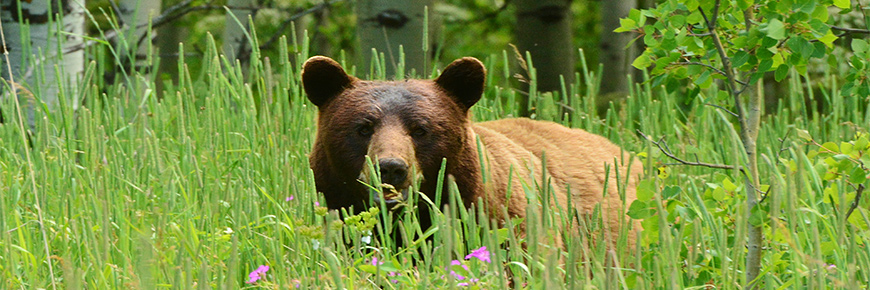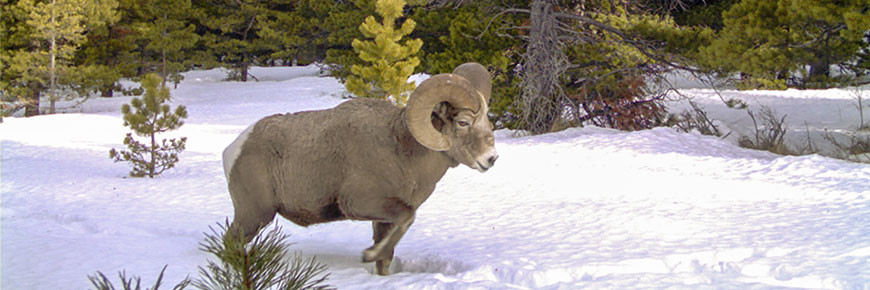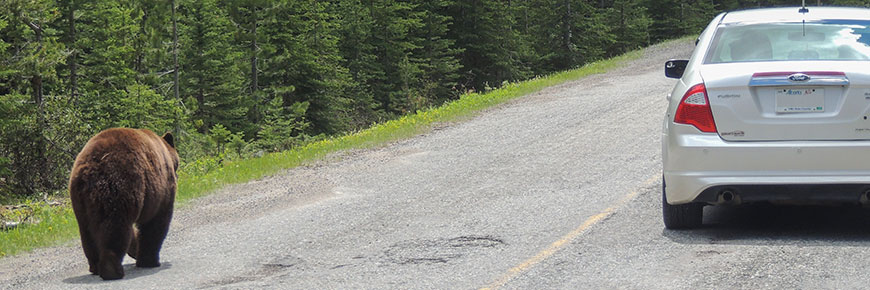Wildlife watching
Waterton Lakes National Park
Whether you plan to drive the roads, hike the trails, or relax in town, there are many opportunities to observe wildlife in Waterton Lakes National Park.
Wildlife can be spotted year round, so keep a look out for the park's 60-plus species of mammals.
With this unique experience comes the responsibility to treat animals with respect. Always give wildlife space. Stay in your vehicle. Do not feed wildlife, this is unlawful in a national park.
Where to watch wildlife

10 animals to spot:
Ten animals you might see when visiting Waterton Lakes National Park:
- Bighorn sheep
- Black bear
- Elk
- Mule deer
- White-tailed deer
- Moose
- Columbian ground squirrel
- American dipper
- Grey jay
- Mountain chickadee
Bighorn sheep, deer and ground squirrels are commonly seen in the community of Waterton.
Small mammals, birds, deer and bighorn sheep are often seen along mountain trails, and the park's grasslands provide important range for elk, mule deer and white-tailed deer.
Black bears are occasionally seen on open slopes, in forested areas, along roadsides, in campgrounds and feeding in berry patches in the lower valleys in late summer.
Late summer and fall are particularly good wildlife viewing times. The grasslands covering the lower mountain sides provide important food sources which attract wildlife; as well as open views which make them more visible.
Ungulates such as deer, elk and bighorn sheep mate in the fall, so they are looking their best at this time; with antlers at peak growth and thick, shiny coats. This is the time of year when you can experience bugling elk and their large harems, or head-butting tests of strength by bighorn sheep.
When viewing wild animals, it is important to treat them with respect. Please take the time to learn some important precautions.
Winter wildlife viewing

Winter can be the best or worst time for watching wildlife - depending on winds and snow. Strong winds push wildlife into sheltered areas and deep snow can make travel difficult for you and the animals.
The Blakiston Fan (south of the Entrance Parkway, between Lower and Middle Waterton lakes) often hosts hundreds of elk, easily seen along the parkway. At the gate area or Lower Waterton viewpoint, you may see elk crossing the Waterton River or river otters swimming by.
Along the Akamina Parkway you might see moose, mule deer, red squirrels, snowshoe hares and marten. Watch for playful river otters at Cameron Lake.
Deer and bighorn sheep are common, especially in the community. A rare highlight would be sighting one of the park’s wild cats (cougar, bobcat or lynx).
The Red Rock Parkway is only accessible in winter by foot, snowshoes and skis, so head out and enjoy tranquil vistas while keeping your eye out for wildlife.
If you don’t see many animals, you will see tracks in the snow. Bring a field guide so you can figure who’s been there (and maybe hiding nearby!)
Respect wildlife and stay safe

The chance of seeing wildlife is one of the most exciting things about visiting Waterton Lakes National Park. However, it is important you treat wild animals with respect. You can start helping from the moment you enter the park:
- Do not surround, crowd or follow an animal
- Never put people (especially children) at risk by posing them with wildlife
- Do not stalk or pursue wildlife
- Never follow an animal into the bush
- Do not try to entice wildlife by feeding or by simulating animal calls (i.e. elk bugling)
Photographers who travel the park in search of good photo opportunities have a responsibility to wildlife and fellow visitors. If you don’t have a telephoto lens (at least 300-400 mm), show the animal in its natural surroundings.
Roads
Be alert along the road. Hundreds of large mammals are killed on roadways in national parks. These accidents often result in injuries to the driver and/or passengers. Roadways attract wildlife because they provide easy travel and roadside forage. To prevent collisions with wildlife, be alert. Use quick glances to scan ahead for animal movements or shining eyes. If you spot one animal, look for others. They often travel in groups. Most importantly, stay within posted speed limits.
If you come across a traffic jam caused by roadside wildlife:
- Slow down. You have more reaction time when you travel slowly. Be aware of traffic, both in front of and behind you.
- Watch the road. Both wildlife and people may suddenly run onto the road. Pull over only if it is safe to do so, keeping your tires within a foot of the road. Never stop in the middle of the road, close to a hill or curve, or in heavy traffic.
- Remain in your vehicle, safe from both wildlife and traffic.
Safety
We recommend you keep at least three bus lengths (30 metres/100 feet) away from large animals and about three times that distance away from bears.
Don't entice wildlife by feeding, reaching out or simulating calls. Feeding or approaching animals too closely causes them to lose their natural fear of people. Once 'habituated', animals are likely to become increasingly aggressive. Approaching too closely threatens their survival, and your safety. While you may feel you can accept the personal risk of this action, you should remember that your actions can help create wildlife behaviours which may cause others to be injured, especially children.
Keep the animal's line of travel or escape route clear. If it approaches you, move away. Retreat immediately if you notice signs of aggression or any behaviour change. For your safety and to protect the bears, Park Wardens may move bears that are persistently too close to people, by using hazing techniques (eg. cracker shells, rubber bullets) to scare them away.
Wildlife reporting
Phone number: To report wildlife, call: 1-888-927-3367.
Try to identify the species and note the animal’s description, behaviour and location:
- unsafe or aggressive human-wildlife interactions
- injured or dead wildlife
- a predator in the townsite, a campground, or near accomodations
- Date modified :